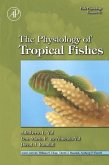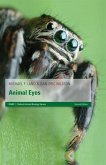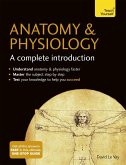Patrick Butler (University of Birmingham School of Biosciences), Anne Brown (University of Exeter School of Biological Sciences), George Stephenson (School of Life Sciences, La Trobe University, Me
Animal Physiology: an environmental perspective
Patrick Butler (University of Birmingham School of Biosciences), Anne Brown (University of Exeter School of Biological Sciences), George Stephenson (School of Life Sciences, La Trobe University, Me
Animal Physiology: an environmental perspective
- Broschiertes Buch
- Merkliste
- Auf die Merkliste
- Bewerten Bewerten
- Teilen
- Produkt teilen
- Produkterinnerung
- Produkterinnerung
Animal Physiology: an environmental perspective provides a broad review of animal physiology, demonstrating how an understanding of the physiology of animals in their natural habitats helps us to understand how and why animals evolved the way they did, as well as how we can protect them from the extreme effects of changes to their environments.
Andere Kunden interessierten sich auch für
![Fish Physiology: The Physiology of Tropical Fishes Fish Physiology: The Physiology of Tropical Fishes]() Adalberto Luis Val / Vera Maria Fonseca de Almeida e Val / David J. Randall (eds.)Fish Physiology: The Physiology of Tropical Fishes159,99 €
Adalberto Luis Val / Vera Maria Fonseca de Almeida e Val / David J. Randall (eds.)Fish Physiology: The Physiology of Tropical Fishes159,99 €![Fish Physiology: Hypoxia Fish Physiology: Hypoxia]() Fish Physiology: Hypoxia138,99 €
Fish Physiology: Hypoxia138,99 €![Exercise Physiology: Integrating Theory and Application Exercise Physiology: Integrating Theory and Application]() William KraemerExercise Physiology: Integrating Theory and Application76,99 €
William KraemerExercise Physiology: Integrating Theory and Application76,99 €![Cardiovascular Physiology: Questions for Self Assessment Cardiovascular Physiology: Questions for Self Assessment]() Rodney J LevickCardiovascular Physiology: Questions for Self Assessment176,99 €
Rodney J LevickCardiovascular Physiology: Questions for Self Assessment176,99 €![Animal Eyes Animal Eyes]() Michael F. Land (Professor of Neurobiology, University of Sussex, UAnimal Eyes87,99 €
Michael F. Land (Professor of Neurobiology, University of Sussex, UAnimal Eyes87,99 €![Human Physiology: An Integrated Approach, Global Edition Human Physiology: An Integrated Approach, Global Edition]() Dee SilverthornHuman Physiology: An Integrated Approach, Global Edition107,99 €
Dee SilverthornHuman Physiology: An Integrated Approach, Global Edition107,99 €![Anatomy & Physiology: A Complete Introduction Anatomy & Physiology: A Complete Introduction]() David Le VayAnatomy & Physiology: A Complete Introduction18,99 €
David Le VayAnatomy & Physiology: A Complete Introduction18,99 €-
-
-
Animal Physiology: an environmental perspective provides a broad review of animal physiology, demonstrating how an understanding of the physiology of animals in their natural habitats helps us to understand how and why animals evolved the way they did, as well as how we can protect them from the extreme effects of changes to their environments.
Hinweis: Dieser Artikel kann nur an eine deutsche Lieferadresse ausgeliefert werden.
Hinweis: Dieser Artikel kann nur an eine deutsche Lieferadresse ausgeliefert werden.
Produktdetails
- Produktdetails
- Verlag: Oxford University Press
- Seitenzahl: 1104
- Erscheinungstermin: 25. Februar 2021
- Englisch
- Abmessung: 277mm x 219mm x 48mm
- Gewicht: 2728g
- ISBN-13: 9780199655458
- ISBN-10: 0199655456
- Artikelnr.: 52625725
- Herstellerkennzeichnung
- Libri GmbH
- Europaallee 1
- 36244 Bad Hersfeld
- gpsr@libri.de
- Verlag: Oxford University Press
- Seitenzahl: 1104
- Erscheinungstermin: 25. Februar 2021
- Englisch
- Abmessung: 277mm x 219mm x 48mm
- Gewicht: 2728g
- ISBN-13: 9780199655458
- ISBN-10: 0199655456
- Artikelnr.: 52625725
- Herstellerkennzeichnung
- Libri GmbH
- Europaallee 1
- 36244 Bad Hersfeld
- gpsr@libri.de
Patrick J. Butler is Emeritus Professor of Comparative Physiology in the School of Biosciences, University of Birmingham J. Anne Brown is Emeritus Professor in the School of Biological Sciences, University of Exeter D. George Stephenson is Emeritus Professor in the School of Life Sciences, La Trobe University, Melbourne, Australia John R. Speakman is Professor of Zoology in the Institute of Biological and Environmental Sciences at the University of Aberdeen.
* PART ONE - ANIMALS AND THEIR ENVIRONMENT
* 1: The diversity of animals and their interactions with natural
environments
* 2: Energy metabolism - generating energy from food
* 3: Cells, organisms and interactions with their environment
* PART TWO - WATER AND SALTS
* 4: Body fluid regulation: principles and processes
* 5: Osmotic and ionic regulation in aquatic animals
* 6: Water balance of land animals
* 7: Kidneys and excretion
* PART THREE - TEMPERATURE
* 8: Temperature and the principles of heat exchange
* 9: Temperature regulation in ectotherms
* 10: Temperature regulation in endotherms
* PART FOUR- OXYGEN
* 11: The respiratory gases, gas exchange and transport: key
characteristics and principles
* 12: Respiratory systems: an overview
* 13: Transport in respiratory systems, and acid-base balance
* 14: Cardiovascular systems: an overview
* 15: Environmental and behavioural influences on the
cardio-respiratory system
* PART FIVE - COORDINATION AND INTEGRATION
* 16: Neurons, nerves and nervous systems: an overview
* 17: How animals sense their environments
* 18: Muscles and animal movement
* 19: Hormones
* 20: Reproduction
* 21: Control of sodium, water, and calcium balance
* 22: Integration of the respiratory and circulatory systems: rhythm
generation and control
* 1: The diversity of animals and their interactions with natural
environments
* 2: Energy metabolism - generating energy from food
* 3: Cells, organisms and interactions with their environment
* PART TWO - WATER AND SALTS
* 4: Body fluid regulation: principles and processes
* 5: Osmotic and ionic regulation in aquatic animals
* 6: Water balance of land animals
* 7: Kidneys and excretion
* PART THREE - TEMPERATURE
* 8: Temperature and the principles of heat exchange
* 9: Temperature regulation in ectotherms
* 10: Temperature regulation in endotherms
* PART FOUR- OXYGEN
* 11: The respiratory gases, gas exchange and transport: key
characteristics and principles
* 12: Respiratory systems: an overview
* 13: Transport in respiratory systems, and acid-base balance
* 14: Cardiovascular systems: an overview
* 15: Environmental and behavioural influences on the
cardio-respiratory system
* PART FIVE - COORDINATION AND INTEGRATION
* 16: Neurons, nerves and nervous systems: an overview
* 17: How animals sense their environments
* 18: Muscles and animal movement
* 19: Hormones
* 20: Reproduction
* 21: Control of sodium, water, and calcium balance
* 22: Integration of the respiratory and circulatory systems: rhythm
generation and control
* PART ONE - ANIMALS AND THEIR ENVIRONMENT
* 1: The diversity of animals and their interactions with natural
environments
* 2: Energy metabolism - generating energy from food
* 3: Cells, organisms and interactions with their environment
* PART TWO - WATER AND SALTS
* 4: Body fluid regulation: principles and processes
* 5: Osmotic and ionic regulation in aquatic animals
* 6: Water balance of land animals
* 7: Kidneys and excretion
* PART THREE - TEMPERATURE
* 8: Temperature and the principles of heat exchange
* 9: Temperature regulation in ectotherms
* 10: Temperature regulation in endotherms
* PART FOUR- OXYGEN
* 11: The respiratory gases, gas exchange and transport: key
characteristics and principles
* 12: Respiratory systems: an overview
* 13: Transport in respiratory systems, and acid-base balance
* 14: Cardiovascular systems: an overview
* 15: Environmental and behavioural influences on the
cardio-respiratory system
* PART FIVE - COORDINATION AND INTEGRATION
* 16: Neurons, nerves and nervous systems: an overview
* 17: How animals sense their environments
* 18: Muscles and animal movement
* 19: Hormones
* 20: Reproduction
* 21: Control of sodium, water, and calcium balance
* 22: Integration of the respiratory and circulatory systems: rhythm
generation and control
* 1: The diversity of animals and their interactions with natural
environments
* 2: Energy metabolism - generating energy from food
* 3: Cells, organisms and interactions with their environment
* PART TWO - WATER AND SALTS
* 4: Body fluid regulation: principles and processes
* 5: Osmotic and ionic regulation in aquatic animals
* 6: Water balance of land animals
* 7: Kidneys and excretion
* PART THREE - TEMPERATURE
* 8: Temperature and the principles of heat exchange
* 9: Temperature regulation in ectotherms
* 10: Temperature regulation in endotherms
* PART FOUR- OXYGEN
* 11: The respiratory gases, gas exchange and transport: key
characteristics and principles
* 12: Respiratory systems: an overview
* 13: Transport in respiratory systems, and acid-base balance
* 14: Cardiovascular systems: an overview
* 15: Environmental and behavioural influences on the
cardio-respiratory system
* PART FIVE - COORDINATION AND INTEGRATION
* 16: Neurons, nerves and nervous systems: an overview
* 17: How animals sense their environments
* 18: Muscles and animal movement
* 19: Hormones
* 20: Reproduction
* 21: Control of sodium, water, and calcium balance
* 22: Integration of the respiratory and circulatory systems: rhythm
generation and control








